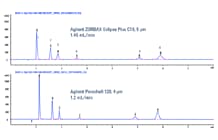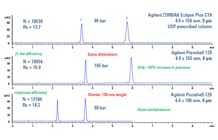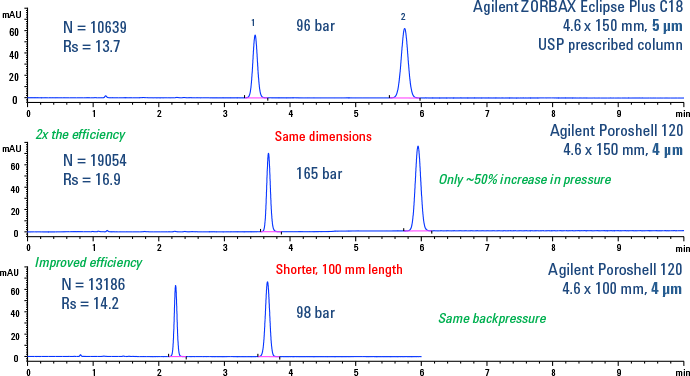Access Agilent eNewsletter February 2015
>> Update My Profile | Subscribe to Access Agilent | Article Directory

Agilent Poroshell 120 columns: 4 µm particle size increases scalability, enables flexible method development
By Jason Link
Agilent Product Marketing Manager, Small Molecule HPLC Columns
Over the past few years, superficially porous particle (SPP) columns have seen tremendous growth as users have recognized their advantages over traditional totally porous columns. For new methods, the popularity of SPP columns has exceeded that of sub-2 µm columns. Major benefits include robustness, high efficiency, and low backpressure. If you still use columns with 5 µm particles and have not yet embraced modern 2.7 µm SPP columns due to concerns of elevated pressures, a 4 µm column may be an excellent choice for you.
Agilent has recently introduced the Poroshell 120, 4 µm column family, which expands the Agilent Poroshell 120 platform with a scalable solution for chromatographers and method developers. This latest platform extension, which consists of EC-C18, EC-C8, Phenyl-Hexyl, PFP (pentafluorophenyl), and HILIC (hydrophilic interaction liquid chromatography) chemistries, allows for easy transition to the Agilent Poroshell 120 family. With half the column pressures of our 2.7 µm Poroshell 120 columns and efficiencies nearly double that of traditional totally porous columns, users who need moderate performance increases can adopt the 4 µm Poroshell 120 columns with ease.
Simple method transfer
Poroshell 120 phase chemistries are scalable with other Agilent ZORBAX chemistries, which makes method transfer from older totally porous 5 µm columns very straightforward. Figure 1 shows the similar performance of Agilent ZORBAX Eclipse Plus C18 when compared with Agilent Poroshell 120 EC-C18.
Scalability from one phase to another is important in method transfer, but scalability between particle sizes is also very important. As you transfer methods throughout an organization and around the globe, you may run them on a variety of instruments, which requires a column chemistry to be available in multiple particle sizes. The Agilent Poroshell 120 chemistries are available in both 2.7 µm and 4 µm particles, which enhances the flexibility of this column family. Figure 2 shows an example.
 Enlarge
Enlarge
Figure 1. Easy method transfer to the more modern and higher performance Agilent Poroshell 120 family.
 Enlarge
Enlarge
Figure 2. USP analysis of naproxen using an Agilent Poroshell 120, 4 µm column as a drop-in replacement for a traditional 5 µm column.
 Enlarge
Enlarge
Figure 3. Note the reduced backpressure of Agilent Poroshell 120 EC-C18, 4 µm column in the analysis of quinolones in milk.
The USP analysis of naproxen shown in Figure 2 traditionally uses a 5 µm totally porous column. But in this case, the original method requires a 4.6 × 150 mm, 5 µm C18 column. When you use a 5 µm Agilent ZORBAX Eclipse Plus C18 column, the method requirements are easily met (top chromatogram).
Transfer to an Agilent Poroshell 120 EC-C18, 4 µm column (middle chromatogram) maintains selectivity. Efficiency nearly doubles, so you can use a slightly shorter column to achieve an even faster analysis (bottom chromatogram). While not as fast as a Poroshell 120, 2.7 µm column, the 4 µm column enables better resolution and efficiency than a 5 µm column at approximately 50% the backpressure of a 2.6 or 2.7 µm superficially porous column.
Remove barriers to optimized methods
Above, in Figure 3 we show another example that uses Agilent Poroshell 120, 2.7 µm and 4 µm columns as replacements for a 5 µm column. In this case, the example shows the analysis of quinolones in milk.
With this gradient method, the scalability between Poroshell 120, 2.7 µm and 4 µm columns is very predictable. For this analysis, the 2.7 µm particle size (top) improves peak width and resolution, but the 4 µm particle size (bottom) provides lower backpressure.
Scalability maximizes your flexibility in method development. With robust, predictable scalability between particle sizes in a column family, you can seamlessly transfer from column to column, regardless of particle size. For older nonoptimized systems, the Agilent Poroshell 120, 4 µm column can provide an ideal solution for separation performance, and you can easily transfer older methods to a Poroshell 120, 2.7 µm column in the future. Predictable performance and selectivity minimize any barriers to method optimization and transfer.
More columns for better results
Agilent has a broad family of phases across all particle sizes and the largest portfolio of fast LC columns for exceptional flexibility and scalability. Whether you perform conventional or ultrafast chromatography or analyze complex mixtures, you can trust Agilent for reliable columns that deliver the fast, reproducible results you need. Take a moment to explore Agilent Poroshell 120 resources, and then use our LC Column Navigator to find the right column for your separation.
>> Update My Profile | Subscribe to Access Agilent | Article Directory
Figure 1.

Peak ID
- Ascorbic acid
- Acesulfame K
- Saccharine
- p-Hydroxybenzoic acid
- Caffeine
- Benzoic acid
Easy method transfer to the more modern and higher performance Agilent Poroshell 120 family.
Figure 2.

Peak ID
- Naproxen
- Butyrophenone
USP analysis of naproxen using an Agilent Poroshell 120, 4 µm column as a drop-in replacement for a traditional 5 µm column. At the same column length, the 4 µm column delivers twice the efficiency at about the same run time. With a shorter 100 mm column, efficiency increases by 24%, with a 33% shorter run time.
